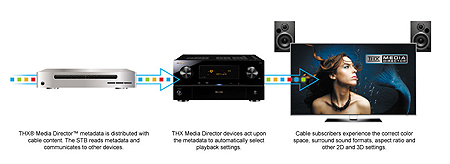THX Media Director

The problem is that consumer audio/video equipment has become increasingly complex, with many new features and controls, and most folks have no clue how to adjust them for optimum results. Even worse, those "optimum results" are often different depending on the source, be it CD, DVD, Blu-ray, broadcast TV, or online download. The settings within a given playback system could well be different to get the most from one format compared to another, and even those consumers with the know-how to adjust them accordingly are unlikely to do so because it's such a hassle to dig into complicated menu systems.
THX has come up with an ingenious solution to this problem. The company's primary mission is to assure that the intent of content creators is reproduced as faithfully as possible. In 1983, George Lucas and Tomlinson Holman founded THXwhich, depending on who you talk to, was named after Lucas' movie THX 1138 or as an initialism for Tom Holman's eXperimentin an effort to improve and standardize the cinema experience. Since then, the company has expanded its certification program to include professional mixing and monitoring studios, home-theater products such as AVRs and flat-panel TVs, DVDs, games, and car-audio systems.

The company's latest technology, dubbed THX Media Director, associates digital audio and video content with metadata about how the content was created, including aspect ratios, 2D/3D formats, EQ settings, DSP mode, number of audio channels, compression format, colorimetry, and so on. The content creator enters this data into a Media Director file, which is stored along with the content itself on packaged media, such as CD or DVD, or encoded and sent along with broadcast or online content.
At the other end of the signal chain, the playback devices must be able to properly handle and interpret the metadata. Disc players load the Media Director files into their onboard memory and send the metadata via HDMI or S/PDIF to an A/V receiver and/or video display. In turn, those rendering components automatically set their controls in response to the metadata, optimizing them for that particular content.
The THX Media Director system can be applied dynamically within a given titlefor example, the metadata might change for different chapters or scenes on a Blu-ray or DVD. An artist could even use the metadata to generate effects for their own sake, using it as part of the content-creation process.
At next week’s CEA Line Shows in New York, THX will demonstrate how Media Director metadata can be delivered over a cable network, enabling the subscriber's set-top box and TV to automatically select appropriate settings, including seamless switching between 2D and 3D modes. I'll be attending the event, so stay tuned for my impressions of this demo.
According to THX Senior VP Rick Deanwho was a recent guest on my podcast"THX Media Director allows content creators to communicate exactly how they want their content to look and sound when presented on home-playback systems. But consumers are the ones who benefit most because they can sit back and truly enjoy the show."





























































